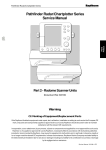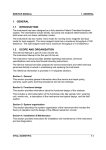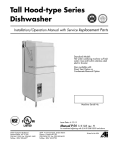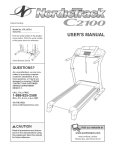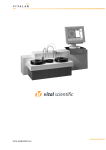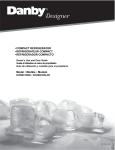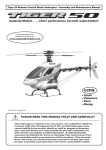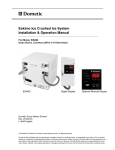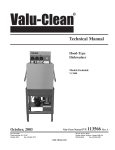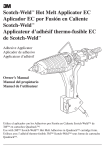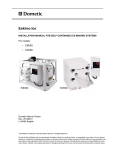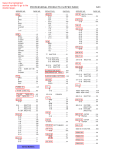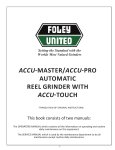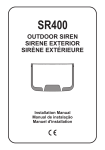Download DDW398 SM
Transcript
SERVICE MANUAL COUNTER-TOP DISHWASHER DDW398W,DDW399W DANBY PRODUCTS LTD. GUELPH, ONTARIO N1H6Z9 DANBY PRODUCTS INC. FINDLAY, OH 45839 Contents 1. Circuit Diagram___________________________________________1 2. Tools and Test Equipment___________________________________2 3. Troubleshooting___________________________________________3 4. Performance Check: Loading_________________________________5 5. Performance Check: Detergent and Rinse Agent__________________7 6. Power Connections_________________________________________8 7. Removing Outer Casing and Control Panel______________________9 8. Inner Wiring Connections Check______________________________10 9. Door Latch Mechanical_____________________________________11 10. Timer___________________________________________________12 11. Power Switch and Option Switch_____________________________15 12. Water Inlet Valve_________________________________________16 13. Pressure Switches_________________________________________18 14. Pump and Motor Assembly__________________________________19 15. Heating Element and Safety Thermostat________________________20 16. Normal Thermostat________________________________________21 17. Hose Connector___________________________________________22 18. Rinse Agent Dispenser______________________________________23 19. Parts List_________________________________________________24 20. Exploded View____________________________________________29 1.Circuit Diagram 1. 2. Tools and Test Equipment Hand Tools A basic compliment of hand tools i.e. flat and phillips head screw drivers, socket set, pliers and wire striper / crimping tool. A basic volt ohm meter (VOM) will also be required for circuit and component testing. 2 3. Troubleshooting Problem Possible Cause Repair Procedure 1.Pump and timer do not run (power pilot is not illuminated) Power receptacle defective Power cord defective Open wire to timer Open door latch switch Power switch defective Kinked fill hose Low houes water pressure Blocked inlet valve or faucet Open or defective pressure switch Pressure switch defective water inlet valve stuck open Pressure switch defective Check receptacle Check power cord Check timer Check wiring and connection Check option switch and power switch Check inlet hose check faucet Check inlet valve and faucet See pressure switch See pressure switch See inlet valve See pressure switch Poor terminal connection on timer Defective timer Drain hose kinked or blocked Resistance or capacitance defect Dishwasher not level Door not closing tightly Crack in hose connection Gasket damaged Inlet valve connector loose or defective Loose connection between pump & sump Pump body damaged Pump seal defective Detergent is old and caked See timer See timer Check drain hose See pump and motor assembly Adjust leveling legs Adjust latch strike Replace hose Replace gasket Check water inlet valve Reconnect using encapsulant Replace pump and motor assembly See pump and motor assembly See detergent and rinse agent Dishes block water from detergent cup No or low water No rinse agent in dispenser Solenoid inoperative Open timer contacts Dispenser gasket defective Dispenser tank cracked Improper loading Detergent old, incorrect type or amount Improper cycle selection Kinked or cloged drain hose Foreign material in wash system Foreign material in spray arm Rinse agent leaks into tub during wash Rinse agent not used heating unit inoperative See loading dishes See #2 Check rinse agent level check rinse agent dispenser Check timer Replace gasket Replace dispenser See loading dishes See detergent and rinse agent Choose proper cycle Check drain hose Check wash system Clean wash arm Replace dispenser Fill rinse agent dispenser See heating element 2. Too little or no water fill 3. Water does not shut off 4. Water pumping out before washing dishes. 5. Timer does not advance 6. Water does not pump out 7. Dishwasher leaks 8. Detergent remains in detergent cup 9. Rinse agent dispenser does not release rinse agent 10. Rinse agent dispenser leaks 11. Poor washing results 12. Poor drying 3 3. Troubleshooting Cont. Problem Possible Cause Repair Procedure 13. Condensation on door 14. Dishwasher door is difficult to open or close Some condensation is normal Door gasket emersion Door linkage bent Door hook deflection Dishes rattling Drain pump viberating Foreign object in pump Silcon sleeve worn Connector hose washer defective Connector gasket damaged Cause- steam vent on door Pull gasket into slot See door latch assembly See door latch assembly See loading dishes See pump and motor assembly Check wash pump See hose connectors Replace washer Replace connector gasket 15. Noise during operation 16. Hose connector leaks 4 4. Performance Check: Loading Many performance problems that commonly occur in dishwashers are not due to mechanical defects. Problems with poor washing results can often be resolved without making repairs. The procedures in this manual are designed to help you eliminate performance problems before you begin checking and testing the dishwasher’s components. To get the best results from the dishwasher it is necessary to form good loading habits. If the dishwasher seem to be running correctly, but does not get the dishes really clean, check to be sure it is being loaded properly. The owner’s manual gives detailed instructions on this procedure. 5 PROCEDURE Loading dishwasher 6 5. Performance Check: Detergent and rinsing agent Water and detergent are major factors for good dishwasher performance. Water pressure, hardness and temperature also play vital roles in getting good results. The correct detergent, in proper amounts, is equally important. The water hardness in your area will effect the amount of detergent needed to get clean dishes. PROCEDURE Checking detergent Step 1: For personal safety always exercise caution when working with any electrical appliance.. Step 2: Only use detergent intended specifically for automatic dishwashers. Make sure the detergent is fresh and dry. Old, caked detergent will not wash well. Step 3: This dishwasher has a rinse agent dispenser, make sure it is filled. The rinse agent makes the water flow off the dishes faster, this reduces spotting and aids drying. NOTE: Check with the local water company concerning the water conditions in your area. With very hard water more detergent may be required for good results. If you have soft water or a water softener, use less detergent. 7 6. Power Connections Dishwashers plug into standard 120 volt wall receptacles with a three pronged (grounded) plug. If the dishwasher fails to operate properly, the power cord may be preventing power from reaching the unit. Most problems associated with the power cord or connection are caused by damage and/or loose connections and will likely be visible. CAUTION: To minimize the possibility of electric shock, be certain that the wall receptacle and circuit are properly grounded before using the dishwasher. Use of a plug adapter to adapt to a two prong outlet is NOT recommended. Under no circumstances should you attempt to cut off or otherwise remove the third prong (ground prong) from the power cord.. PROCEDURE Inspecting: Power Connections Step 1: Be sure all dishwasher Controls are turned off Step 2: Inspect power cord at connection to receptacle. Improper connection could be the sole cause of trouble. Step 4: Inspect plug carefully for Damaged, corroded or loose terminals. Look for signs of overheating around the molded portion. If plug is damaged replace the power cord. Step 3: Pull plug from receptacle with a firm quick tug. Always grasp the plug, never pull the cord. Be careful Not to contact the blades of plug. Step 5: To replace cord, disconnect remove mounting screws on power cord strain relief . Disconnect internal connections and install new cord same as original. Reassemble dishwasher and check operation. 8 7. Removing Outer Casing And Control Panel PROCEDURE Removing outer case Step 1: For your personal safety exercise caution when working with any electrical appliance. Step 2:Remove stainless--steel screws on both sides of outer casing. Step 4: Remove casing screws on rear of unit Step 5: Lift casing straight off 9 Step 3:Open door and remove six Screws on left and top edges of inner liner. Step 6: Remove six screws fastening front control cover. 8. Inner Wiring Connections Check Power is carried to the components of the dishwasher by a network of insulated wires. These wires are connected to the timer, switches and other dishwasher components by means of push-on connectors. It is very important that the wiring be free of any damage. Any cut that reduces the diameter of the wire reduces the amount of power it will carry. Also, the wire may overheat and eventually break at that point. If the terminals become dull and oxidized they should be replaced. Whenever servicing the wiring harness be sure to note the of any green and / or yellow/brown ground wires in the area in which you are working. Be certain all are properly connected upon completion of service. This is vital to avoid danger of shock or short circuit. CAUTION: CAUTION If replacement wire is required, use only appliance wire having the same temperature and guage rating as the wire you are replacing. This information is usually printed on the wire itself. PROCEDURE Repairing wiring and connections Step 1: Be sure all controls are turned OFF. Disconnect power supply at distribution panel or unplug power cord from outlet. Watch for sharp edges. Step 2: This procedure requires the removal of the outer casing. If you are unfamiliar with this process, please refer to procedure #7:Removing outer Casing. 10 Step 3: Inspect all push-on terminals and inner connecting wiring for signs of damage. i.e. burnt, pinched, loose or frayed. 9. Door Latch The door latch is essential to the operation of the dishwasher. Latching the door closes a switch allowing electrical current to flow to the timer. The timer controls all other components. If the door latch switch is open, the dishwasher will not operate. The latch switch cannot be activated while the door is open. This safety mechanism prevents the dishwasher from being operated when the door is open. However, if the door latch switch contacts become stuck in the closed position, the dishwasher will not stop when door is opened during the cycle. PROCEDURE Door Latch Switch Replacement Step 1: Always unplug from receptacle before repairing. Step 2: Remove outer casing. Step 4: Install new microswitch and connect same as original installation. 11 Step 3: Check for defects in microswitch or connections. If switch is bad remove the two mounting screws. Disconnect and replace switch. 10.Timer The dishwasher timer consists of a timer motor and a variety of switches that automatically controls every phase of the dishwashers operation. The timer motor runs at a constant speed, like a clock. As it advances through the selected cycle, the timer’s internal switches open and close in a precise sequence. When a preset period has elapsed, the timer opens the switch again and shuts off the power to that component. All outgoing wires from the timer are number-coded. By referring to the circuit diagram, you can trace the path of electrical current from the timer to any component. The timer is a very reliable mechanism. It is best to eliminate all other possible causes before attempting to test or replace the timer. PROCEDURE Inspecting and replacing timer Step 1: Be sure all controls are turned OFF. Disconnect power supply at distribution panel or unplug power cord from outlet. Watch for sharp edges. Step 2: This procedure requires the removal of the outer casing. If you are unfamiliar with this process, please refer to procedure #7:Removing outer Casing. Step 3: To check timer motor, set the timer to the off position and check for continuity through the motor windings (approx. 2k ohms). If the windings are open replace timer. Step 4:Refer to dishwasher’s circuit Diagram page 1 to see which contacts close to activate a particular component. (Example:4 to 4a close for drain pump) Refer to the timing chart on page 14 to determine when the individual contacts close . FRONT OF UNIT 12 PROCEDURE Inspecting and replacing timer (Continued) Step 5:Remove the leads from the Terminals to be checked. Using an ohm meter, check the resistance through the contact while turning the timer. If the contacts being checked do not close at the appropriate times during the cycle, replace the timer . Step 8: Remount new timer Step 6:To remove the timer, remove the two timer mounting screws. Step 9: Reassemble dishwasher, apply power and test operation. 13 Step 7:Move leads terminal for terminal to the new timer. Timer : Cam Timing Chart 14 11. Power switch and option switch When you press the power switch on, and the dishwasher remains dead with no power light this may be a malfunction of the power switch. When you press the option switch and the heating element can not be energized and the Sani/Econo light does not come on, this may be a malfunction of the option switch. PROCEDURE Inspecting / replacing : power switch and option switch Step 1: Be sure all controls are turned OFF. Disconnect power supply at distribution panel or unplug power cord from outlet. watch for sharp edges. Step 2: This procedure requires the removal of the outer casing. If you are unfamiliar with this process, please refer to procedure #7:Removing outer casing.. Step 4: If the switch is defective, replace the switch and reconnect same as original installation. 15 Step 3: Using a ohm meter, check for bad contacts in the power or option switches. 12.Water inlet valve The water inlet valve controls the flow of water into the dishwasher. A solenoid coil attached to the valve housing creates a magnetic field when energized. This magnetic field pulls open a plunger inside the valve allowing the water to flow through and into the dishwasher. The water fill is controlled by the timer, which opens the valve for a predetermined amount of time Under normal conditions the tub should fill to approximately 85mm. or 3.5in. from the bottom of the sump. Open the dishwasher after any fill cycle to check for normal water level. A malfunctioning water inlet valve solenoid may only allow the dishwasher to fill intermittently. In this case no water will enter the dishwasher during the rinse cycle. This problem can best be diagnosed by operating the dishwasher and listing for the water entering during each fill cycle. PROCEDURE Inspecting and replacing : Water inlet valve Step 1: Be sure all controls are turned OFF. Disconnect power supply at distribution panel or unplug power cord from outlet. watch for sharp edges. Step 4: If water fill is less than normal,detach fill hose to expose filter screen. Clean or replace as necessary. Step 2: This procedure requires the removal of the outer casing. If you are unfamiliar with this process, please. refer to procedure #7:Removing outer casing.. Step 5: Using a ohm meter check for continuity through the solenoid. If solenoid winding is open, replace valve. 16 Step 3: Locate valve where inlet hose is attached. Check wires and valve body. Step 6: To replace water valve, shut off water supply and disconnect faucet coupling. PROCEDURE Inspecting and replacing: Water inlet valve (continued) Step 7: Disconnect incomming water Water supply hose. Remove clamp and detach smaller hose running into dishwasher tub. Step 8: Remove mounting screw that secures fill valve to rear panel. Install new valve and reconnect leads and water lines. Reassemble dishwasher and reconnect water and power supply. NOTE: If water continues to fill, even when power is disconnected, this is caused by damage to, or sediments in valve housing or bellows. In either case entire valve should be replaced. NOTE: If open winding in solenoid were proceeded by continuous filling and draining. Make sure timer is Advancing through the fill cycle. Continuous duty will burn out water valve solenoid. 17 13. Pressure Switches There are two pressure switches on the dishwasher. One is for controlling normal water level set at approx. 85mm or 3.5 inches of water in sump. This will be referred to as the Normal Pressure Switch. The other one is for preventing overflow and is set for approx. 102mm or 4 inches of water in sump. This one will be referred to as the Safety Pressure Switch. If the water in the tank rises above the pre-set level, the safety pressure switch opens the Circuit and stops power to the fill valve and closes the circuit to the drain pump, expelling excess water. The safety pressure switch shuts water off only in cases of electrical malfunction. If a mechanical defect or foreign object causes the inlet valve to stick open, the safety pressure switch will not be able to stop the overflow. The safety pressure switch should never cut off the water inlet valve solenoid during normal fill, if it does it is not properly adjusted. PROCEDURE Inspecting and replacing: Pressure switch Step 1: Be sure all controls are turned OFF. Disconnect power supply at distribution panel or unplug power cord from outlet. watch for sharp edges. Step 2: This procedure requires the removal of the outer casing. If you are unfamiliar with this process, please. refer to procedure #7:Removing outer casing.. Step 4: If the water level is incorrect Check the pressure switch connecting hoses and all connections to see if there is air leakage and pressure loss. Reseal any loose connections. Step 5: If a pressure switch is bad remove mounting screw and replace switch. 18 Step 3: Hold a ruler vertically in the sump, the tub should fill between 81-87mm or 3.25 to3.5 inches. Step 6: Pressure switches must be adjusted with a special screwdriver to the proper level (step 3). After adjustment is complete a drop of glue should be placed on the Threads to prevent further movement 14. Pump and Motor Assembly The circulation pump and drain pump are combined and driven by the same reversing motor. The timer activates the circulation winding during wash and the drain winding during pumpout with pauses between changes in direction. PROCEDURE Inspecting and replacing: Pump and motor assembly Step 1: Be sure all controls are turned OFF. Disconnect power supply at distribution panel or unplug power cord from outlet. watch for sharp edges. Step 4: Turn dishwasher up side down. Remove 4 motor mounting and bracket mounting screws. Release wire clips and remove bottom panal. Step 2: This procedure requires the removal of the outer casing. If you are unfamiliar with this process, please refer to procedure #7:Removing outer casing.. Step 5: Using a ohm meter, check the pump motor windings. Wash winding = blue lead on resistor Drain winding = #14 on safety pressure switch. Common = black lead on fill valve. 19 Step 3: Unclip and remove washarm. Unthread and remove washarm base nut. Step 6: If defective, release hose camps and replace pump and motor assembly. 15. Heating Element and Safety Thermostat The heating element is located at the bottom of the sump. When the unit is energized during the heated wash cycle , it heats the water. The warmed air rises through the sump cover into the tub providing efficient washing and drying of the dishes. An inner resistance coil of nichrome wire, which does the actual heating, is completely surrounded by an electrical insulation material. This assembly is protected by a metal sheath to help reduce damage and oxidation. Since you can’t see the internal coil, in most cases you will have to rely on the ohm meter to determine the condition of the coil. The safety thermostat acts as a temperature limit switch. If a malfunction causes the temperature rises above the Limit of the thermostat, the heating element is disabled preventing damage to the dishwasher. PROCEDURE Inspecting and replacing: Heating element and thermostat Step 1: Be sure all controls are turned OFF. Disconnect power supply at distribution panel or unplug power cord from outlet. watch for sharp edges. Element Step 2: This procedure requires the removal of the outer casing. If you are unfamiliar with this process, please. refer to procedure #7:Removing outer casing.. Step 3: The heater and thermostat are located on the left side of the dishwasher in the end of the sump. remove wires and inspect visually for burned or damaged connections. Thermostat Step 4: Using an ohm meter, remove the wires And check for continuity through the element And safety thermostat independently. If either component checks open,“no reading”, it is bad and needs to be replaced. Step 5: To replace either componant, remove the two mounting nuts using a 8mm or 11/32 deepwell scocket. Install new component and re assemble dishwasher. 20 16. Normal Thermostat The normal thermostat is used to control the water temperature during the wash and final rinse when the sani option is selected. When the sani option is selected, the timer stops at specific points in the cycle and the heating element is energized. When the water temperature reaches 154 F or 67.7C the thermostat contacts close and the timer continues through the cycle. The extra water heating period assures temperatures high enough to produce good wash results. PROCEDURE Inspecting and replacing: Normal Thermostat Normal thermostat Step 1: Be sure all controls are turned OFF. Disconnect power supply at distribution panel or unplug power cord from outlet. watch for sharp edges. Step 2: This procedure requires the removal of the outer casing. If you are unfamiliar with this process, please. refer to procedure #7:Removing outer casing. Step 4: Using an ohm meter remove the wires and check for continuity across the thermostat terminals. These contacts should always be open at room temperature so if there is any reading at all the thermostat must be replaced . Step 3: The normal thermostat can be accessed from the left side of the dishwasher and is on the back of the sump. Step 5: To replace the normal thermostat remove the two mounting screws and install the new component. Reassemble dishwasher and check operation. 21 17. Hose Connector The hose assembly is made up of a water inlet hose, a drain hose and a hose connector. The hose connector fastens to the kitchen faucet by means of a faucet adapter. The hose connector also has a pressure relief button to relieve pressure before disconnecting and allows water to be used in the sink while the dishwasher is operating. PROCEDURE Inspecting and replacing: Hose Connector Step 1: Be sure all controls are turned OFF. Disconnect power supply at distribution panel or unplug power cord from outlet. watch for sharp edges. Step 2:Inspect hoses for cracking or deterioration. Disconnect and replace as necessary. Step 4: Replace washers in all Leaking hose connections. Reassemble dishwasher and Check operation. 22 Step 3: Any leaks in the connector are resolved by replacing the hose connector as an assembly. 18. Rinse Agent Dispenser The rinse agent dispenser on dishwashers automatically inject a small amount of liquid rinse agent into the dishwasher during the final rinse cycle. This wetting solution acts to break down the surface tension of the water, minimizing the formation of spots and streaks on dishes and glasses. The dispenser tank holds about one month supply of agent. During the final rinse the timer activates a solenoid on the dispenser assembly. The solenoid pulls up a rubber tipped valve pin allowing a small amount of agent to be released into the tank where it is distributed by the action of the water. PROCEDURE Inspecting and replacing: Rinse agent dispenser Step 1: Be sure all controls are turned OFF. Disconnect power supply at distribution panel or unplug power cord from outlet. watch for sharp edges. Step 2: If rinse agent is leaking inside, remove and inspect cap and washer. reassemble wipe off tank and wait 5 Minutes. If seepage still shows replace the dispenser assembly. Step 4: Check wiring connections and terminals. Replace or repair any faulty connections. Using an ohm meter check for solenoid for continuity. If the coil is open “no reading “ replace the coil. 23 Step 3: Remove six screws and small access cover on rear of dishwasher. Inspect tank for signs of leakage. If the tank is cracked or split, replace the dispenser assembly. Step 5: To remove the dispenser assembly, remove the fill cap and mounting nuts from inside the tub. after the mounting nuts are removed, the dispenser assembly con be replaced from the access panel on rear. Ilus No. 1 2 3 4 5 6 7 8 9 10 11 12 13 14 15 16 17 18 19 20 21 22 23 24 25 26 27 28 29 30 31 32 33 34 35 36 37 38 39 40 41 Description Door Spring Front Cover Facing Bar Filter Assembly Outer Casing Outer Casing Screw Absorbtion Proofed Connecting Hose Clamp 24 Name Plate Inlet Hose Clamp 16 Spray Arm Assembly Spray Arm Base Screw Spray Arm Base Gasket Front Cover Bottom Pan Foot Motor Base Rubber Pad Washer Pressure Switch Bracing Bar Pressure Switch (normal) Pressure Switch (safety) Clamp 24 Clamp 26 Drain pump Drain Hose Clamp 45.1 Clip Nut Sump Heating Element Heating Element Gasket Heating Element Mounting Plate Thermostat #1 Thermostat #1 Clamp Sump Gasket Thermostat #2 Sump Tap Clamp 26 Drain pump Inlet Hose Circulation Hose Clamp 41.5 Pressure Switch Connecting Hose 24 Qty Per Unit 1 1 1 2 1 1 3 1 1 2 1 1 1 1 1 5 4 4 1 1 1 1 1 1 1 7 5 1 1 1 1 1 1 1 1 1 1 1 1 1 1 Part No. 1.398 2.398 3.398 4.398 5.398 6.398 7.398 8.398 9.398 10.398 11.398 12.398 13.398 14.398 15.398 16.398 17.398 18.398 19.398 20.398 21.398 22.398 23.398 24.398 25.398 26.398 27.398 28.398 29.398 30.398 31.398 32.398 33.398 34.398 35.398 36.398 37.398 38.398 39.398 40.398 41.398 Ilus No. 42 43 44 45 46 47 48 49 50 51 52 53 54 55 56 57 58 59 60 61 62 63 64 65 66 67 68 69 70 71 72 73 74 75 76 77 78 79 80 81 82 Description Pressure Switch Connector Pressure Switch Connector Hose Clamp 22 Thermostat #2 Gasket Pressure Switch Connector Hose #2 Spray arm hose Circulation outlet gasket Circulation pump Circulation wheel Diaphragm Drain wheel Motor axial gasket Pump gasket Drain pump assembly Motor bracing bar Resistor Capacitor Motor Fan Outer door assembly Door left hinge Pulley Pulley axial Door bracing bar Inner door Door hook Ventilation window gasket Ventilation window Ventilation window cover Door right hinge Door gasket 1 Inner container assembly Door gasket 2 Front left bracing bar Screw Screw gasket Left rear bracing bar Top rubber plate Inlet connector 1 Inlet connector 2 Inlet connector gasket 25 Qty Per Unit 1 1 2 1 1 1 2 1 1 1 1 1 1 1 1 1 1 1 1 1 1 2 2 1 1 1 1 1 1 1 1 1 1 1 6 6 1 1 1 1 2 Part No. 42.398 43.398 44.398 45.398 46.398 47.398 48.398 49.398 50.398 51.398 52.398 53.398 54.398 55.398 56.398 57.398 58.398 59.398 60.398 61.398 62.398 63.398 64.398 65.398 66.398 67.398 68.398 69.398 70.398 71.398 72.398 73.398 74.398 75.398 76.398 77.398 78.398 79.398 80.398 81.398 82.398 Ilus No. 83 84 85 86 87 88 89 90 91 92 93 94 95 96 97 98 99 100 101 102 103 104 105 106 107 108 109 110 111 112 113 114 115 116 117 118 119 120 121 122 123 Description Right rear bracing bar Dispenser gasket Dispenser solenoid Dispenser cover #1 Dispenser mounting screw Dispenser cover #2 Dispenser body assembly Door lock holder Slider Door lock spring #1 Spring #1 washer Door lock screw Door lock base Qty Per Unit 1 2 1 1 1 1 1 1 1 1 1 2 1 Part No. 83.398 84.398 85.398 86.398 87.398 88.398 89.398 90.398 91.398 92.398 93.398 94.398 95.398 Insulation piece Door lock spring #2 Linkage Microswitch Right front bracing bar Wobbler Wobbler spring Axis Forel ring Rear panel Power cord clamp Insulation porcelain Lug Inlet valve Inlet valve mounting plate Drain hose connector Power cord Power cord pad Turn knob Switch button Control panel Door button Pilot cover Control panel bracing bar Tumbling rod hinge Tumbling rod hinge Pilot holder 1 1 1 1 1 1 1 1 1 1 1 1 2 1 1 1 1 1 1 2 1 1 2 1 1 1 1 97.398 98.398 99.398 100.398 101.398 102.398 103.398 104.398 105.398 106.398 107.398 108.398 109.398 110.398 111.398 112.398 113.398 114.398 115.398 116.398 117.398 118.398 119.398 120.398 121.398 122.398 123.398 26 Ilus No. 124 125 126 127 128 129 130 131 132 133 134 135 136 137 138 139 140 141 142 143 144 145 146 147 148 149 150 151 152 Description Pilot Power switch Option switch Timer Door lock button spring Cross recessed pan head Tapping screw Cross recessed big pan head Tapping screw Cross recessed big pan head Tapping screw Cross recessed big pan head Tapping screw Cross recessed pan head Thread forming screw Cross recessed pan head Tapping screw Grounging screw Spring washer Inside swath locking washer Plain washer #4 Hexagon nut Cross recessed pan head Tapping screw Cross recessed pan head Tapping screw Open baffle Cross recessed pan head thread Forming screw Plain washer #5 Cross recessed pan head screw Cross recessed pan head screw Cross recessed countersunk head screw Cross recessed pan head Tapping screw Cross recessed pan countersunk head Tapping screw Hexagon nut M5 Hexagon nut M12 X 1.5 Hexagon nut M16 X 1.5 27 Qty Per Unit 2 1 1 1 1 45 Part No. 124.398 125.398 126.398 127.398 128.398 129.398 10 130.398 8 131.398 8 132.398 4 133.398 3 134.398 5 7 5 5 3 2 135.398 136.398 137.398 138.398 139.398 140.398 5 141.398 1 3 142.398 143.398 3 4 2 4 144.398 145.398 146.398 147.398 4 148.398 4 149.398 8 1 1 150.398 151.398 152.398 Ilus No. 153 154 155 156 157 158 159 160 161 162 163 164 165 166 167 168 169 170 171 172 173 174 175 176 177 178 179 180 181 182 Description Cross recessed pan head tapping screw Cross recessed pan head tapping screw Cross recessed pan head tapping screw Cross recessed pan head tapping screw Cross recessed pan head screw Cross recessed pan head forming screw Cross recessed pan head tapping screw Cross recessed pan head screw Connecting wire Instruction manual Service manual QC passed sticker Plastic bag Inlet hose assembly Drain hose assembly Packing pad #1 Packing pad #2 Packing pad #3 Packing pad #4 Hose holder Wire basket Cup rack Basket wheel Wheel axis Silverware basket Quick connector assembly Condenser nut Condenser gasket Condenser Small rear cover 28 Qty Per Unit 2 2 2 3 2 1 2 4 1 1 1 1 3 1 1 1 1 1 1 1 1 1 1 1 1 1 1 1 1 1 Part No. 153.398 154.398 155.398 156.398 157.398 158.398 159.398 160.398 161.398 162.398 163.398 164.398 165.398 166.398 167.398 168.398 169.398 170.398 171.398 172.398 173.398 174.398 175.398 176.398 177.398 178.398 179.398 180.398 181.398 182.398 29 30 31 32 33 34 35 36 37 38








































